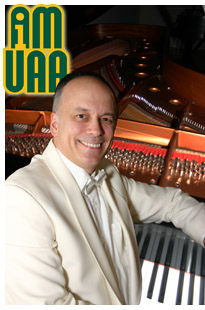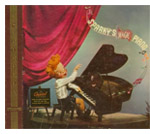I AM UAA: Timothy Smith, D.M.A.
by Kathleen McCoy |
 Professor of Music, Associate Dean for the Fine Arts, College of Arts and Sciences
Professor of Music, Associate Dean for the Fine Arts, College of Arts and Sciences
Hometown: Seattle, Washington
Fun Fact: Once asked a translator for a second piano bench for a duet performance in China and
minutes later several men burst through the concert hall door carrying a second grand
piano on their shoulders.
Inside Professor Timothy Smith's office you'll find typical academic office essentials: a computer, books, notepads, pens and a standard-issue office chair. Less typically, you'll also find two grand pianos and heavy, sound-absorbing draperies lining the bunker-thick walls. It seems the Fine Arts Building planners knew its halls would be alive with orchestrated musical progress and took a few precautions to limit how far that music could travel. At least indoors.
Tim, a 27-year veteran of the UAA Department of Music who has been ensconced in the building since its grand opening in the '80s, has certainly let his music do some traveling off campus. In addition to performing in North and South America, he's given concerts and master classes throughout Asia: Japan, China, Korea, Hong Kong and Taiwan. Fall, winter and spring are generally reserved for teaching classes, working with his piano students and academic administration at UAA, but summers see him traveling the globe sometimes accompanied by his wife and fellow pianist, Rumi.
Though warned by a music professor in college never to marry another pianist, Tim and his wife have been married for 21 years during which they've maintained complementary careers. And they haven't worried too much about the best way to furnish their home. With three pianos (two at midlevel and one down), Tim laughs, "we don't need as much furniture as other people." Guests are welcome to pull up a piano bench. The Smiths, in their travels, have also been known to play duets on occasion, including a performance of "The Butterfly Lovers" in Guangzhou, China, last year. (Watch the duet at the 13-minute mark.)
So, how does one become a successful academic and award-winning musician? If you're Tim, you start when you're just four years old. "There was always music in our house," he says. His mother was musical, playing piano and marimba and performing with the Bremerton Symphony as a percussionist. As a little kid, he remembers hearing one record (a 78 for those who speak vinyl) that prompted him to sit down at the piano and learn the piece by ear. "I still have it," he says of the record. "I rescued it from my parents' basement. It's called Sparky's Magic Piano."
 His parents, impressed by his early piano aptitude, took him to his first piano instructor
at age five. "She said I was too young and they said, 'maybe you should hear him play
this piece.' I sat down and played that piece from the record. It was about a 32-bar
piece, or something, but you know, both hands." She was impressed and perhaps a little
dumbfounded. When his parents explained that he'd taught himself after hearing the
record, Tim recalls with a smile, "She said, 'well, I guess you can start.'"
His parents, impressed by his early piano aptitude, took him to his first piano instructor
at age five. "She said I was too young and they said, 'maybe you should hear him play
this piece.' I sat down and played that piece from the record. It was about a 32-bar
piece, or something, but you know, both hands." She was impressed and perhaps a little
dumbfounded. When his parents explained that he'd taught himself after hearing the
record, Tim recalls with a smile, "She said, 'well, I guess you can start.'"
A few years later, at age 10, Tim had his first opportunity to attend Juilliard. During a stay in New York while his father was doing doctoral work at Columbia, Tim auditioned for a pre-college program at nearby Juilliard and was accepted along with other young musicians. "It was definitely some serious piano instruction, that's for sure. Maybe even more serious than a 10 year-old would appreciate in some cases, although I was pretty focused," he says. "I was kind of driven by the competitive aspect of it." And he loved his introduction to 1960s New York. "It was gritty and unique-it was what you'd see in West Side Story," he says.
Lured by the city and more of the competition offered by one of the country's best music schools, Tim returned to Juilliard as a graduate student after studying at University of Washington. Music, Tim's ticket to good schools, also helped keep him afloat while he was a student. "I also played the organ," he says. "I could do church services and weddings." After Juilliard, he went on to complete his doctoral degree at the State University of New York at Stony Brook, now Stony Brook University.
Tim made his New York debut at Carnegie Recital Hall (now Weill Recital Hall) in 1985. He's quick to point out that the recital hall is a smaller venue beside the grand and storied Carnegie Hall where he hasn't yet had a chance to play. "A lot of young pianists give their debut recitals [in the recital hall]. Used to be they could get a review from the New York Times. In fact, I was one of the few lucky ones who got someone to actually show up." The review in the New York Times referred to his debut performance as "polished, powerful and energetic." Playing at Carnegie Hall during the month of Tim's debut was a very famous pianist and Carnegie Hall regular, Vladamir Horowitz. "My poster was up on the wall on 57th Street and five paces down, there was his poster," Tim says. Seeing his name beside Horowitz's was surreal.
The same year Tim gave his Carnegie debut recital, he accepted a faculty position from UAA. "This was actually my first position out of grad school," he says. Intrigued by the idea of Alaska, he accepted UAA's offer and became one of three full-time faculty in music at UAA in 1985. And while he won't claim to be a music department pioneer, he played a key role in gaining accreditation from the National Association of Schools of Music for UAA's music program early in his tenure as department chair.
Spring 2012 was Tim's last as department chair since he has taken on another new administrative role: Assistant Dean for the Fine Arts for the College of Arts and Sciences. He'll be staying put in his own office, however, rather than joining the incoming CAS dean over in the Social Sciences Building. No room for even a smallish grand piano there. And he's looking forward to continuing to work with his music students and collaborating on a scientific study using Bogdan Hoanca and Kenrick Mock's eye-tracking technology.
Atop the office piano is a black box, a little bigger than a DVD player. It's an eye scanner used to capture students' eye movements when they're reading music. In students with good eye motion, the readout shows a sort of saw-toothed wave. "Kind of like a heart monitor," Tim says. They're currently gathering data and will analyze it to determine a baseline or ideal for the way an eye tracks music. "Like all research, there's an idea, but we won't know where it's going to go until we gather the data and look at it." He plans to work with students outside of UAA as well to broaden the study.
Continuing to work with students and balance that with administration and his own artistic development is something Tim is looking forward to. "I've found a balance that hopefully I can maintain," he says. "I know retirement is something that happens when you stop working, but I'm not counting the days. I'm still working and it's too interesting. You know, as long as I can keep doing what I'm doing, then retirement is just something that happens later."
 "I AM UAA: Timothy Smith, D.M.A." is licensed under a Creative Commons Attribution-NonCommercial 4.0 International License.
"I AM UAA: Timothy Smith, D.M.A." is licensed under a Creative Commons Attribution-NonCommercial 4.0 International License.









